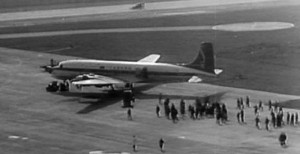Published July 9, 2012
On this day in aviation history, July 9, 1961, began of the one of the greatest civilian evacuation operations ever undertaken in the history of Africa. The operation would last three weeks, culminating on July 28 and would evacuate former colonial staff, administrators, military and families from the newly independent, conflict-stricken nation of the Congo. The airlift would not be undertaken by a large nation with a massive military and a huge airlift arm, but rather by the tiny nation of Belgium, whose colonial holdings of the Congo were making an ill-fated transition to independence. All of the evacuation flights would be operated by or chartered through SABENA (Societe Autonyme Belge d’Exploitation de la Navigation Aerienne), Belgium’s national air carrier.
Evacuation by Air
Incredibly, the airlift evacuated a total of 34,484 passengers in just three weeks time. Many were evacuated not just from regional airports, but first from outlying farms and ranches, from small villages and towns, and from isolated outposts spread across the vast, largely unconnected jungle landscape of the Congo. Many evacuations were done by helicopter first, sometimes under the cover of light attack planes. Sabena itself carried the bulk of those rescued, accounting for fully 25,711 passengers. Of those, 1,888 were infants, 8,327 were children, 9,742 were women and 5,754 were men. The entire operation was achieved with 209 flights by Sabena’s Boeing 707s (62 flights), DC-7Cs (66 flights) and DC-6s/DC-6Bs (81 flights). At the peak on July 14, a total of 3,066 passengers were flown out all the way to Brussels, Belgium. On July 17, a SABENA 707-329 flew out a record 293 passengers, including children and babies, along with its usual crew complement of 10.
It seems strange that the situation in the Congo had so rapidly devolved that an emergency airlift of that magnitude was required. With hindsight, such violence should have predictable and many of the Belgian citizens living there had been warning of the brewing problems for some time. Further, the Belgian track record of colonial rule was one of the worst examples in Africa. Whereas the British and French had taken pains in their colonies to educate the local population and train them in government administration, the Belgians had left a tribal social system in place. Education was almost non-existent. For decades, Belgium’s primary focus had been on exploiting the country’s copper, cobalt, diamond and uranium mines. The local population was viewed as cheap, expendable labor. As a result, beneath the surface, there simmered deep resentment and anger.
After unsuccessfully pressing for a 30 year transition to independence, in 1959, the Belgian government authorized the people of the Congo to form political parties. A rushed date for independence was set for June 30, 1960. Only one month before independence, the first elections were held — hardly enough time to enable a stable transition. Predictably, the Congolese gathered into political parties along tribal lines, but from among the tribal groups, a single leader emerged by adding fuel to the fires of anger in the hearts of the people. His name was Patrice Lumumba and he became the first prime minister in the new coalition government alongside the new head of state, President Joseph Kasavubu.
With the dawn of independence, Belgium’s King, Baudouin, arrived in Léopoldville to give a speech highlighting the virtues of Belgian colonialism. Predictably, the Congolese were outraged and in response, the newly sworn in Prime Minister Lumumba thundered “Nous ne sommes plus vos singes,” (We will not be your monkeys anymore) as the crowds roared their approval. The King left in a hurry as the streets of the colony’s capital, Léopoldville, descended toward chaos.
The Roots of Civil War
Behind the scenes, however, a different game than the public farce of independence was about to play out. Belgium tried to hold onto control of the country’s natural resources by creating a new proxy state in the south. Instead of a “military withdrawal,” Belgium simply transferred their forces into a new command structure, setting the stage for a civil war with European intervention. Seven days after independence, the southern provinces of Katanga and Kasai seceded. With Belgian troops and air power, plus the fact that virtually all of the Congo’s natural resource wealth were in Katanga and diamond-rich Kasai, the plan seemed secure. The new Congo government up north reacted with extreme rage and a full blown civil war broke out. It was into this crisis that SABENA undertook the evacuation of Belgium’s citizens.
Afterward, a long and painful conflict would overtake the Congo, the legacy of which continues even to this day. The fighting would pit the provinces of the Congo against one another. More massacres of Belgian and other Western (and even American) citizens and missionaries would follow. It would bring in hundreds of hardened mercenaries to Katanga, many of which were former SS and Wehrmacht soldiers from French Foreign Legion and veterans of Algeria. The conflict would also provide an open door to increased Soviet involvement in central Africa.
To combat Soviet influence, the Eisenhower Administration would order the CIA to assassinate Patrice Lumumba, who was seen as Soviet-leaning — but they would not be successful and the Belgians themselves would do the job. The new Kennedy Administration in Washington would later deploy a secret air force manned in part by Cuban Exile pilots who were veterans of the Bay of Pigs. A full scale conflict would involve the United Nations not as peacekeepers but as direct combatants on the battlefield. Ultimately, the crisis in the Congo would even cost the life of UN Secretary General Dag Hammarskjold, whose plane would crash while en route for peace talks. Today, the legacy of the conflict is still reflected in violence and “blood diamonds.”
Yet for SABENA, the Congo rescue mission of 1960 is nothing less than “its finest hour.”
One More Bit of Aviation Trivia
Though few people know it, the Congo also is linked to the atomic bombs dropped on Hiroshima and Nagasaki, Japan, by the USAAF at the end of World War II. These early nuclear weapons used uranium for the fission reaction to yield an explosion. That uranium was supplied by none other than Belgian colonial assets in the Congo, mined by local African laborers. The Belgians, having suffered under the Nazis (who were allied with the Japanese and Italians together as the so-called “Axis Powers”) supplied the uranium to the US War Department, even if they were not told the ultimate use. Perhaps they could have guessed, but maybe not — more likely, they were just glad to supply the uranium to another buyer. In any case, few except the physicists knew the theoretical potential of atomic weapons and the mushroom clouds rising over Japan carried the fingerprints of the Congo.



Dear Sir
Reading your note on the Sabena operations related to the evacuation of Belgian citizen out of Congo I do have a doubt as to what year it was exactly. You are writing about 1961 and I always thought it was in 1960.
Could you please help me clearing this out?
I thank you for your help and expecting your answer I herewith send you my best regards.
Michel Anciaux
Santiago de Chile
Sir —
The airlift you describe was the emergency evacuation airlift conducted by Sabena in July 1960. I know because my father was one of the many engineers who participated on the flights. Thanks.
Eddy J Van Beeck